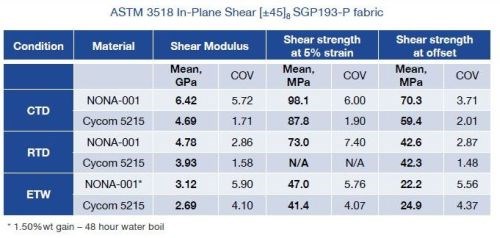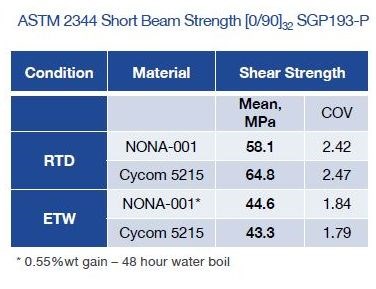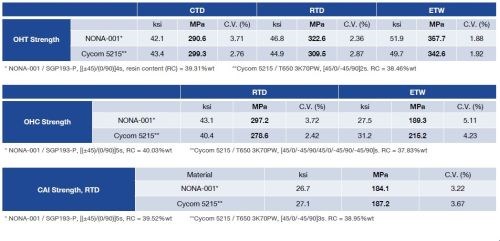No-oven, No-autoclave (NONA)
Room-temperature cure epoxy composites with a 400°F Tg, comparable properties vs. commercial systems without external heat or post-cure, and offering reduced cost and cycle time. Really?
Share

Slightly curved composite tool for Space Launch System (SLS) test panels.
SOURCE: NONA Composites, LLC
No-oven, No-autoclave (NONA) composites technology was developed by Cornerstone Research Group (CRG, Dayton, Ohio) through a 2010 SBIR in conjunction with the National Aeronautics and Space Administration (NASA) Glenn Research Center (Cleveland, Ohio, USA) and is now being commercialized by CRG’s spinoff, NONA Composites LLC (Dayton, Ohio). The original goal was more cost-effective processing of large composite structures and tooling without the large capital expense of autoclaves, ovens or heated tools for cure.
NONA is largely based on what the company terms “commercial off-the-shelf” (COTS) technology. The NONA-001 two-part epoxy resin uses readily available COTS components, combined in its own proprietary formulation. It is processed using conventional resin infusion and low-cost machined foam tooling (i.e., COTS polymeric tooling board). The innovative part is controlling the resin’s exothermic reaction and capturing its heat to achieve full cure and high temperature properties. NONA Composites LLC claim laminates with a glass transition temperature (Tg) of 400°F/204°C achieved via a two-hour cure and six-hour cool-down cycle, enabling service temperatures up to 350°F/177°C.
Recent developments were reviewed in the SAMPE Tech 2013 (Oct 21-24, Wichita, Kan., USA) paper, “No-oven, no-autoclave processing for NASA composite structures”, including construction of a 127cm by 66cm (50-inch by 26-inch) carbon fiber skin/aluminum honeycomb sandwich part and a 117cm by 107cm (46-inch by 42-inch) curved carbon tool as preparation for building a 1:10 scale payload fairing section (including upper barrel and ogive) tool for the NASA Space Launch System (SLS) heavy-lift launch vehicle. The SLS tooling project is now underway and currently scheduled for completion by late Spring 2014. This is one of many out of autoclave (OOA) composite technologies NASA is exploring (see “Tooling up for larger launch vehicles” in September 2013 CT).
NONA composites have also been tested using National Institution for Aviation Research (NIAR, Wichita, Kan.) specifications, in order to provide a comparison with a currently used matrix system — Cycom 5215 OOA epoxy resin from Cytec (Tempe, Ariz., USA), which has an extensive properties listing in the National Center for Advanced Materials Performance (NCAMP) database. The SAMPE paper cited similar performance in seven-day boil, open hole tension (OHT), open hole compression (OHC), and compression after impact (CAI) testing. Compression and tensile properties are still being completed, but the damage tolerance an shear properties have been released (see below). The total number of specimens tested so far is still relatively small, but the initial results look promising. Fiber volumes have ranged from 62 to 67 percent by weight with void content consistently below 1 percent.




Comparison of NONA process thermal and mechanical performance
to conventional OOA system. SOURCE: NONA Composites, LLC
“We are now working with composite tooling and structures manufacturers,” says Ben Dietsch, NONA Composites LLC chief operating officer, “and have an inventory of resin available to support the increased interest we have received.” He explains companies are seeking reduced cycle time and the ability to make high performance tools from low-cost master models using foam, which machines faster and reduces tooling weight vs. higher density epoxy tooling board. According to Dietsch, though savings are greatest with larger tools, time and cost reductions can be achieved with tools as small as a couple of square feet. “We compare favorably versus LTM tooling prepreg, for example, and we’re also demonstrating advantages beyond tooling, in secondary and tertiary structures.” NONA Composites is also looking forward to primary-type structures, investigating how the NONA resin and curing technology can be combined with toughened prepreg to enable processing benefits for systems already qualified with desired fiber volume and damage tolerance properties.
NONA Composites will exhibit their latest developments at the Wasatch Front Materials Expo (March 5, Salt Lake City, Utah, USA) and CAMX (Oct 13-16, Orlando, Fla., USA).
Related Content
PEEK vs. PEKK vs. PAEK and continuous compression molding
Suppliers of thermoplastics and carbon fiber chime in regarding PEEK vs. PEKK, and now PAEK, as well as in-situ consolidation — the supply chain for thermoplastic tape composites continues to evolve.
Read MoreBladder-assisted compression molding derivative produces complex, autoclave-quality automotive parts
HP Composites’ AirPower technology enables high-rate CFRP roof production with 50% energy savings for the Maserati MC20.
Read MoreNovel composite technology replaces welded joints in tubular structures
The Tree Composites TC-joint replaces traditional welding in jacket foundations for offshore wind turbine generator applications, advancing the world’s quest for fast, sustainable energy deployment.
Read MoreComposite resins price change report
CW’s running summary of resin price change announcements from major material suppliers that serve the composites manufacturing industry.
Read MoreRead Next
VIDEO: High-volume processing for fiberglass components
Cannon Ergos, a company specializing in high-ton presses and equipment for composites fabrication and plastics processing, displayed automotive and industrial components at CAMX 2024.
Read MorePlant tour: Daher Shap’in TechCenter and composites production plant, Saint-Aignan-de-Grandlieu, France
Co-located R&D and production advance OOA thermosets, thermoplastics, welding, recycling and digital technologies for faster processing and certification of lighter, more sustainable composites.
Read MoreAll-recycled, needle-punched nonwoven CFRP slashes carbon footprint of Formula 2 seat
Dallara and Tenowo collaborate to produce a race-ready Formula 2 seat using recycled carbon fiber, reducing CO2 emissions by 97.5% compared to virgin materials.
Read More





















